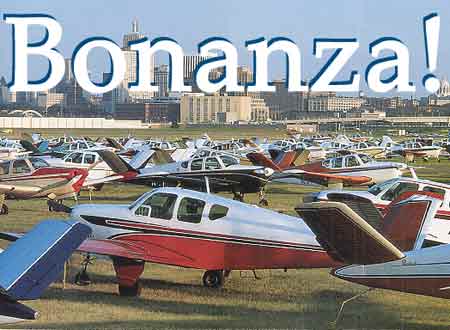
PAGE FIVE
Bonanza F33, F33A, F33C - 1970
The 225 hp F33 for for 1970 introduced a few nicities like
a quick opening cowl, but the 285 horse F33A was produced
in two versions with no model designations to differentiat
them. The 1970 version was your basic straight-tail Bonanza
with a big motor, but the 1971 version got the long cabin
of the contemporary Bonanza which moved the aft bulhead
back 19 inches. This gave room for two full sized seats
in the rear and the large cargo door. The aerobatic version
of the airplane continued for one more year, 1970, but
only five were built, making the aerobatic Bonanza one
of the more sought after airplanes of the breed.
| Model | Year | Prices | Speed, knots |
| F33 | 1970 | $92,000 | 161 |
| F33A | 1970 | $102,000 | 172 |
| F33A | 1971 | $108,000 | 172 |
| F33C | 1970 | $131,000 | 174 |
The F33A continued to be produced until 1994 with the predictable
escalation of prices.
| Model | Year | Prices | Speed, knots |
| F33A | 1975 | $126,000 | 172 |
| F33A | 1980 | $151,000 | 172 |
| F33A | 1985 | $167,500 | 172 |
| F33A | 1990 | $205,000 | 172 |
| F33A | 1994 | $236,000 | 172 |
Bonanza G33 - 1972
The little 225 hp airplane that started out as the Debonair
had a 260 hp I0-470-N put under the cowling and was produced
for two more years before Beechcraft decided it didn’t
make sense to be producing two airplanes which were so
similar in every way, including price. With the bigger
engine came a new, roomier interior and all the other appointments
given the “real” Bonanzas.
| Model | Year | Prices | Speed, knots |
| G33 | 1972 | $102,000 | 168 |
| G33 | 1980 | $105,000 | 168 |
Model 36 Bonanza
By 1968 Cessna and Piper had both built airplanes which were
aimed at supplying a heavy hauler for those serious about
moving a lot of cargo and people. The Cessna 206/107 line
and Piper’s Cherokee Six series were making good money
and Beechcraft wanted a piece of that pie. Their initial
effort was to simply move the bulkhead back 19” on
an E series fuselage and stretch it 10”. Then they
repositioned the fuselage on the wing, moving it 10” forward,
which make it possible to load all six seats with 170 pound
passengers and still be in the CG envelope. The first two
years, 1968/69, they tried to market the airplane as a
stripped down, utility airplane, as it’s huge side
door and spacious cabin seemed to point in that direction
for their marketing department. But they were wrong. The
market didn’t want a Beechcraft without Beechcraft
luxury. If they wanted a truck, they would buy something
else, but the market saw the airplane as simply an extension
of the line that gave them a true limosine. Beechcraft
responded by going back to what they know best and put
all of the well known Bonanza touches back in the machine.
The airplane started with the 285 hp Continental of all the
other Bonanzas but, in 1984, received 300 horses and was
turbocharged in 1979. The airplane has proven to have terrific
marketing legs because it has remained in continuous production
since it was introduced.
| Model | 1968 | 1978 | 1988 | 1998 |
| A36 | 36 | A36 | A36 | A36 |
| Avg. Value | $167,000 | $168,000 | $268,000 | $400,000 |
| HP | 285hp | 285hp | 285hp | 300hp |
| Cruise | 170 kt | 168 kts | 169 kts | 169 kts |
| A36TC intro’d 1979 | 1979 B36TC** | B36TC | 1988 | 1998 |
| Avg. Value | n/a | $173,000 | $287,000 | $465,000 |
| HP | n/a | 300 hp | 300 hp | 300hp |
| Cruise | n/a | 190 kts | 190 kts | 190 kts |
*intro’d 1984
** Intro’d 1982, longer wing, gross increased 200
pounds
Summary
What can be said about an airplane that, in one form or another,
has been in continous production since 1947? Not even the
omnipresent C-172 can make that claim. If one thing can
be said, it would have to be that Beechcraft proved that,
even in the toughest times, quality sells and, on the few
occassions they tried to cut their quality, as with the
initial Debonairs and 36’s, sales faltered. They have
carved out a niche at the very top end of the single-engine
market that isn’t likely to be taken over by anyone.
Period!
Want another view point on similar topics? Return to ARTICLES